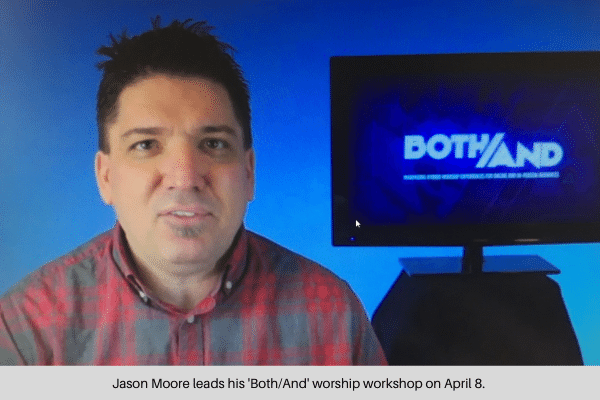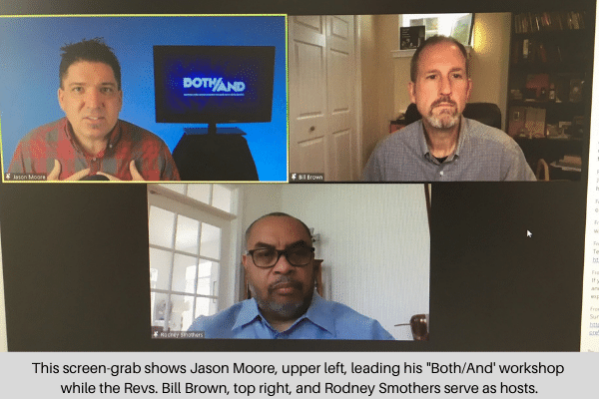Both/And worship here to stay, expert says
By Erik Alsgaard

When the pandemic hit more than a year ago, churches throughout the Baltimore-Washington Conference and around the world had to be flexible, and quick. Because in-person worship wasn’t an option, congregations turned to technology to live-stream their worship services as best they could.
Today, as in-person worship is slowly returning to pre-pandemic levels, what is a church to do with these two worship experiences? Does a church return to in-person only? Do they keep doing what they’ve been doing for the last 14 months?
Jason Moore, a church worship expert, provided answers to these questions and more during an online workshop on April 8. “Both/And: Maximizing Hybrid Worship Experiences for Online and In-Person Audiences,” was offered twice that day, morning and evening. The training was sponsored by the BWC’s offices of New Faith Expressions, led by the Rev. Bill Brown, and Leadership and Congregational Development, led by the Rev. Rodney Smothers.
Brown said that the laity and clergy have been incredibly nimble and flexible in the last year.
“They had to pivot with little warning to online worship,” Brown said. “Now that a year has passed, so many are yearning to return to normal, whatever that may be. However, the reality is that we can’t go back. We must be prepared for the new ‘now’ which includes both in-person and online worship. This is why our offices sponsored the Both/And webinar. Our role is to help equip the leaders in our congregations to embrace this new reality.”
Moore, too, noted how impressed he was with what churches did to adjust to challenging circumstances.
“I’m in awe of what you’ve done,” Moore said. “You have met the moment and brought the Gospel to people in new ways. Even though it may not have been perfect, you’ll get nothing but praise from me.”
However, he said, moving forward, creating a truly hybrid worship service means more than “just putting a camera in a room” and turning it on. To do this, he said, pastors and worship leaders need to reimagine how they do worship. That’s because some elements of in-person worship don’t translate well to the online experience and vice versa.
“What is your theology and methodology of online worship?” Moore asked. “We’ve spent years figuring out our theology of in-person worship, but we’ve only spent the past year examining our theology and practice of online worship.”
And, he said, “being slick is not as important as being authentic.” That doesn’t mean you sacrifice quality, but that whatever a church does with online worship needs to be true to the church’s mission and ministry.
 More adaptations are needed, he said, to continue effectively reaching new people for Christ online. People engage with online worship differently than in-person. For example, studies show that most people don’t sing hymns during online worship. Moore also strongly suggested not going beyond a 40-minute online worship service.
More adaptations are needed, he said, to continue effectively reaching new people for Christ online. People engage with online worship differently than in-person. For example, studies show that most people don’t sing hymns during online worship. Moore also strongly suggested not going beyond a 40-minute online worship service.
“You have to consolidate the story,” he said, citing examples of when books are made into movies. “In the last year, we have changed the terms of worship. It used to be that we set the terms: people came to our buildings at a time we appointed. But a year ago, we took worship to them on their turf, on their terms. They may watch on delay. They may skip the parts they don’t want to watch. We have broadened our reach and we can’t expect that everything that we knew about worship prior to the pandemic translates to those who are watching at home.”
Moore urged participants to re-examine their worship experience, both online and in-person, and ask, “how do these pieces connect? Is this a pageant or a variety show?” In other words, is worship a series of people popping up and performing, doing their act, and there’s no narrative or theme that holds it all together?
“With an online audience,” he said, “if the first thing doesn’t relate to the second thing, and the second thing doesn’t relate to the third thing, it’s much easier for an audience to turn it off. If you’re worshipping in person, you’re not going to get up and leave if that happens. Online, it’s a different experience.”
Telling a story during worship is key, he said, and he outlined four questions to be answered as you examine your narrative.
- What is your driving Scripture for this worship service?
- What are the felt needs of someone who is in worship?
- What is your hook? What does that look like?
- What is the goal? What do you want people to do at the end of your worship?
Moore offered three strategies for making Both/And worship happen and, he said, these work whether a church is small or large, urban or rural, technology savvy or not.
The first way to think about Both/And, he said is “Pre-Both/And worship.” These are two separate worship experiences, he said. The online experience is recorded ahead of time exclusively for the online community, and in-person is exclusively for those who show up.
“If you’re in a church without good Internet, this model may be the one for you,” Moore said. A church can pre-record the worship on your smartphone and upload it before Sunday morning, he said.
The upside of this model is that the online worship experience can be recorded, edited, or adapted, he said. The pastor also has to look at only one audience at a time, either the camera when recording for online worship, or the in-person congregation.
The downsides of this model include the need for having more people involved in the production of worship, either from helping to record, upload/download the worship, and editing. This model also calls for greater advanced planning, additional skill sets that some pastors don’t have, and a steep technological learning curve.
The second strategy Moore offered is what he called “Real-time Both/And Worship.” This is where the whole church worships together, both in-person and online. This is the most complex form of planning worship because you have to think about serving both audiences at the same time, he said.
One option, he said, to address the online community separately is to start your in-person service at, say, 10 a.m., but the online worship starts at 10:15. An online “worship host,” standing in a separate room in the church, welcomes the online worshippers at the start, sets the table, and then they join the service “already in progress,” Moore said. This takes practice, planning, and patience.
The third strategy he noted is the “Post Both/And Worship.” This is where a church records the live worship service, edits it for length (no more than 40-45 minutes), and posts it later YouTube, Facebook, and/or their own website.
Online giving has taken on new urgency during the pandemic, Moore said, but churches still need to teach people how to give online.
“You give up 100% of the offerings you don’t receive,” he said. That means people need to know how to give online, and everyone needs to know why they give. To teach people how to give online may take some effort, Moore said, including the pastor taking time during the service to walk people through the steps of electronic giving.
“Money needs to follow mission, not budget,” Moore said. “Tell the stories of how your offering makes a difference in someone’s life.”
Another big change for some churches may be moving the announcements to the end of the service, instead of doing them right at the start.
“Rather than doing announcements upfront, give people an ROI of the experience they’re going to have with you,” Moore said. (ROI means “returns on investment.”) “Set the table for what’s coming up. Consider doing announcements as action steps.”
What that latter piece means, Moore said, is turning your usual church announcements into opportunities for people to engage with the church, the community, and online.
For example, Moore said, instead of simply stating that the UMW is going to meet, say something like “A great way to put your passion about women and children’s issues is to join our United Methodist Women’s group; they meet …”
As the world opens, more churches will face the challenge of how to address in-person and online worshippers. The most important thing, Moore said, is to realize that returning to what used to be before the pandemic is no longer an option for churches seeking to thrive and make disciples.
The time for learning and experimentation continues. The time for both/and has arrived.
